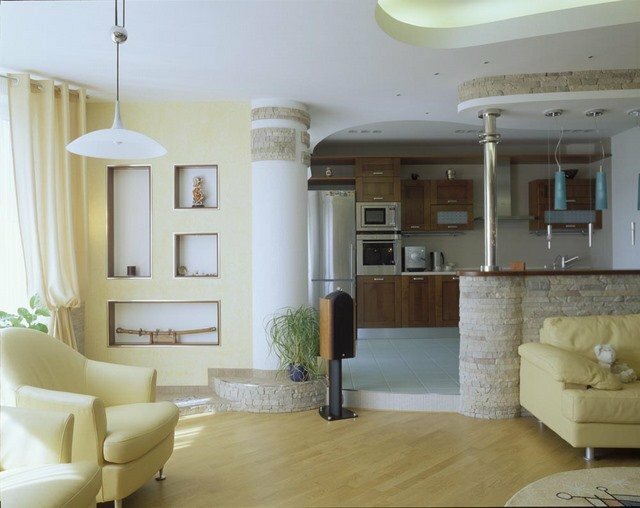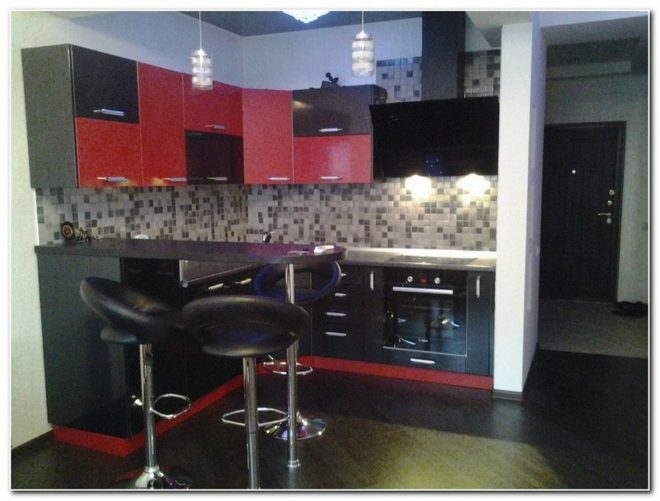A kitchen-living room or a kitchen-studio is a very popular solution for organizing living space today. If earlier such combined rooms were possible only after redevelopment, today there are many ready-made housing with similar layouts on the market. The kitchen-living room gives more space to implement any ideas. However, it also requires a careful study of design, furniture arrangement, zoning in order for the room to be functional and comfortable.

Pros and cons of kitchen design combined with a living room (photo)
This option is ideal if you are the owner of a very small kitchenette of modest size. Combining these rooms will allow you to get much more free space in which you can place a large work area and a full dining table.
Attention! Earned on our website kitchen designer. You can familiarize yourself with it and design your dream kitchen for free! May also come in handy wardrobes designer.

If you often receive guests, then combining the cooking and eating areas will make serving and serving dishes easier - you don't have to run for a missing spoon or a new dish between rooms.

If you love watching TV while cooking, you don't need to have two - the large screen in the living room will be visible to everyone.

Perhaps one of the main advantages is that the kitchen-living room will be the heart of the house, where the whole family can gather. Housekeeping moms will be able to take an active part in the life of the rest of the family - children playing in the living area, doing their homework at a large table or watching a movie with their dad.

There are also drawbacks to this layout - if you are limited in the amount of living space, then donating, for example, your bedroom for the sake of the living room is definitely not worth it. Also, many people may not like the smells of cooking food, which in one way or another will be present in the living area. However, a powerful hood will help to solve this problem.

The counter between the hall and the kitchen - correct zoning
Since the kitchen space is multifunctional, it is important to properly zone it. Basic design techniques that allow you to visually divide into zones:
- bar counter;
- sofa (read how to place it here) and the dining table behind it;
- different floor coverings such as porcelain stoneware in the kitchen area and laminate in the living room;
- split-level floor - for example, the kitchen area is raised above the rest of the room;
- multilevel ceilings;
- different lighting in each zone;
- color schemes that clearly divide the room into parts.
Often, several of these techniques play a role in zoning.

Dividing the kitchen with a bar counter
This is the most common and appropriate option for delimiting the space between the hall and the kitchenette. It is perfect for both large rooms and very modest rooms. Its advantage is its versatility, because it not only visually complements the space, but can serve work surface, dining table or light snack when serving food at a large table is not time.

It can be mobile (in the form of a small console, for example, on wheels), but more often it is made stationary - freestanding, wall-mounted or combined with furniture.

In small rooms, the rack can be very narrow and short, about 30-40 cm wide and 60 cm long. Only one person can fit behind it, but this is ideal for a small bachelor studio. For larger rooms, where a large family gathers, an island would be the ideal solution - this is a large freestanding structure at least 1 meter wide and about 1.5 meters long. Often, wardrobes or even household appliances are built into it, making it an extension of the workspace.
When is the bar not needed?
Very often in pursuit of style and interior "like a magazine" the owners and designers are trying to fit everything that is possible into the project of the room, thereby cluttering the space with pieces of furniture.

This often happens with the counter, which, in addition to zoning, does not have any function.
How to understand that you can do without it? If the kitchen work surface is large enough and family members have enough time to eat at the table rather than on the run, it may not be used often. It will also be superfluous in houses where it is customary to gather at the table with the whole family.

It is also difficult to sit comfortably on a high bar stool, even if it is equipped with a back and armrests. This is especially true for the elderly and children. It is also better for such families to save space and put a full dining table.
Which option to choose
First of all, when choosing, you need to pay attention to the size of the room. If the room is small, then the rack should be no more than 60 cm long and about 30 cm wide. For large rooms - from 1.2 meters in length and 60 cm in width. However, even for a large room, a small counter is possible, designed only for zoning the space, for a morning cup of coffee and reading a newspaper.

Its height depends on functionality and configuration. If it is part of a kitchen unit, then its height will be flush with the countertop - from 85 to 90 cm. But they can also be high - their height can reach 130 cm.

It is important to choose the material. It is often the same as that found on kitchen furniture. For example, if the rack is a narrow tabletop on a chrome support, it can be made of chipboard or MDF.

A more solid option, for example, based on a pedestal, and not on a thin support. Then it can be artificial or natural stone, wood (read also Decoration under a tree).
And more options:

Light kitchen option

Orange kitchen

Kitchen space zoning option

Dividing the kitchen area

Dining room in gray tones

Combining living room and kitchen

Living room separation option

Dining room interior with living room

Small kitchen design
average rating 0 / 5. Number of ratings: 0
No ratings yet. Be the first to rate.


